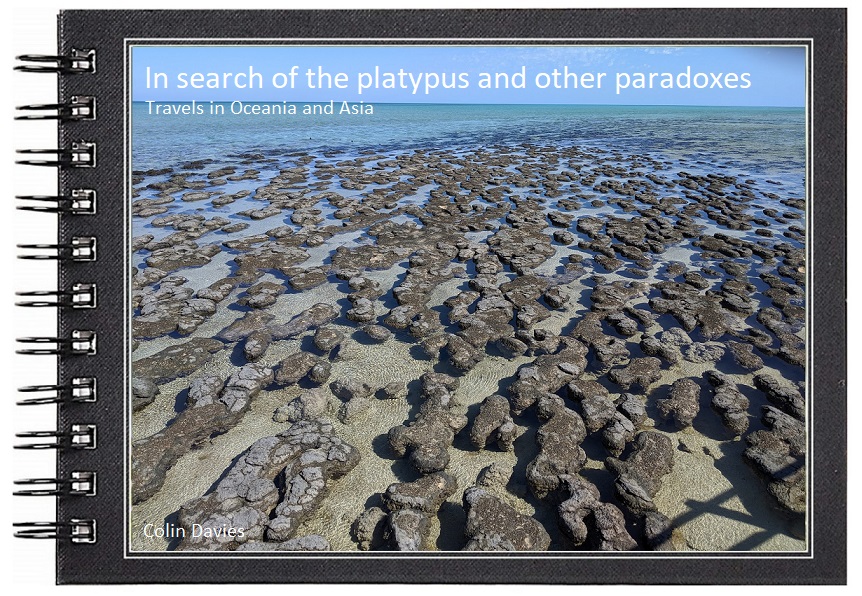Thursday, 24 October 2019
Ningaloo Reef, Western Australia
The opportunity to visit the Ningaloo Reef in Western Australia was one of the main attractions when planning this particular holiday. It's what is known as a fringing reef which means that it occurs close to shore and in fact the Ningaloo reef is considered to be one of the most accessible reefs in the World because in many places you can simply swim out to it from the shore.
Some would argue that it's more impressive even than the Great Barrier Reef, but though I've now been to both it's unfair of me to make a comparison. Not a great snorkeler, I'm also a poor swimmer and certainly I'm no diver, all of which makes it difficult for me to truly experience coral reefs and even more difficult therefore to make comparisons. However, armed with a brand new snorkel fitted with prescription lenses I gave it a go, and there was always the fall back of a glass bottom boat! Josh on the otherhand is a much better swimmer and snorkeler and even better he has an underwater camera with which he was able to take the first 10 or so of the photographs on this post.
I don't know a lot about coral reefs other than what most people know, they are animals not plants, they cover about 1% of the ocean yet contain about 25% of all marines species . They are also extremely beautiful places either for their colours or their intricate patterns and shapes, and they are under threat from climate change and pollution.
I've never before seen so many turtles as we saw on this holiday, though this green turtle is the only one we saw while snorkeling. During our frequent walks on the beach we also saw quite a few turtles surface quite close inshore and watch us as we passed by, including more greens and a few loggerheads.
Amazing to think that Josh took this with his under water camera. Green turtles can grow up to around 1.5m long from nose to tail, but this was probably half that size.
There are some incredibly impressive corals down here! This is one of the brain corals.
Quite a few giant clams as well.
Taken through the bottom of the glass bottom boat, this is a loggerhead turtle which like the green turtles can grow up to 1.5m long. They have a much more sturdy head than the green turtles and this individual can be identified as a male due to its long tail.
There were lots of fish, some much more colourful than these, swimming amongst the coral.
This mermaid even came and cleaned the bottom of the boat for us 😉.
Josh drifting past.....
The massive structure on the left, taken through the boats glass bottom and also seen from the surface in the photo below is known locally as Ayers Rock and is a 4m high and 9m diameter coral which is thought to be 3,500 years old!
Shark Lagoon at Coral Bay is a nursery for reef sharks and during our visit there were about 150 present.
Along with the blue whale at Dunsborough a couple of weeks ago, one of the highlights of our trip was finding this huge green turtle egg laying on a beach at Cape Range near Exmouth. It really is the stuff of dreams. Seeing them swimming in a coral reef is one thing, seeing them surface and watch you as you stand on the shore is another, but to find a female egg laying like this on a beach is like stumbling across the filming of a David Attenborough show. I estimated that this was about 1.5m long, and the hole it was digging probably around 2.5m diameter. We watched it under red light from our head torches for a few minutes and took a few quick photos and then left it alone. When we returned about half an hour later it was still there and we didn't need a torch because a full moon had risen and we could see it clearly in the moon light.
Amazing!
The beaches around the Ningaloo Reef have many shore birds including great knot, grey-tailed tattlers, Terek sandpipers, greater sandplovers, red-capped plovers, sanderling and red-necked stints, but most impressive to me where the terns, with several different species of all shapes and sizes seen.
Caspian, crested and roseate terns.
Brown noddy's are birds of the tropics and I have seen lots of them on the cays of the Great Barrier Reef, but this was the only one we saw on this trip.
Eastern reef egrets occur in two forms, white and dark. In my experience dark is the commoner, outnumbering the white form by 3-1 but this is very unscientific and in reality may be completely wrong! Note how short the legs are of this species compared to those of other egrets and herons.
This is the dark form of eastern reef egret, taken at Port Douglas in Queensland in October 2015.
Subscribe to:
Post Comments (Atom)
-
Photo: Snowy albatross. "Wanderer at 6 o'clock!", the cry went up and sent shivers down my spine. This was the moment I ha...
-
I've been to Southern India twice now, but neither were birding holidays. The first was to meet the family of my son's...
-
Philips Island is a 90 minute drive south east of Melbourne. It's a proper island but you can drive onto it via a bridge. The day we ...


































No comments:
Post a Comment